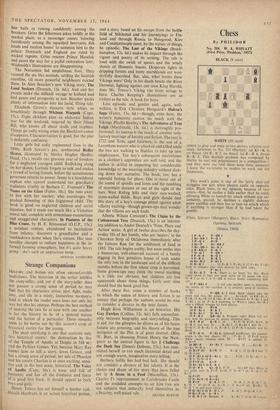Strange Companions
• HISTORY and fiction are often uncomfortable bedfellows. The historian in the writer inhibits the story-teller, and yet if the story-teller does not possess a strong sense of period he may find that his characters strive, plot, fight, make love, and die in a misty, featureless no-man's- land in which the reader soon loses not only his Way but also his interest. Perhaps the best method of making the two lie at ease with one another is for the history to be of a general nature and the fiction of a particular. These remarks seem to be borne out by this season's crop of historical stories for the young.
The most satisfying is one that contains only two historical events: the destruction by fire of the Temple of Apollo at Delphi in 548 BC; and the Pythian Games. Yet, because Mary Ray knows how to tell a story, loves Greece, and has a strong sense of period, her tale of Phaedon and his cousin Charilas is at once exciting, sensi- tive and, in the best sense, historical. The Voice of Apollo (Cape, 16s.) is tense and full of humanity and has all the freshness and force ora good first book. It should appeal to both boys and girls.
Henry Treece has set himself a harder task. llarald Hardrada is an actual historical person,
and a story based on his escape from the battle- field of Stiklestad and his journeyings to Fin- land and through Russia to Novgorod, Kiev and Constantinople must, by the nature of things, be episodic. The Last of the Vikings (Brock- hampton, 12s. 6d.) makes its impact through the vigour and poetry of its writing. The talc is loud with the swish of spears and the windy shouts of Homeric boasts. Desperate fights in dripping forests and misty marshlands are won- derfully described. But, alas, what brutes these Vikings were! Only in his death beside the River Derwent, fighting against our own King Harold, does Mr. Treece's Viking rise from savage to hero. Charles Keeping's illustrations are as violent as the tale. A book for boys.
Less episodic and gentler and, again, well- written, is Erik Christian Haugaard's Hakon's Saga (Faber, 13s. 6d.)—though, even here, the writer's humanity cannot do much with the Vikings. Phyllis Bentley's The Adventures of Tom Leigh (Macdonald, 13s. 6d.) is thoroughly pro- fessional; its success is the result of another satis- factory marriage of history and fiction. The year is 1722 and Tom, aged fourteen, is the son of a Lavenham weaver who is attacked and killed while the two are walking to Halifax to take up new employment. The boy's subsequent misfortunes as a clothier's apprentice are well told, and the author is skilful in imparting her considerable knowledge of the weaving industry without slow- ing down her narrative. The book, too, has a splendid feeling for place. One is never out of the sound of spindle and loom and the tumbling of mountain streams or out of the sight of the bare West Riding hills and their rain-washed, stone-walled fields. Boys and girls should find this story of a boy's courage pitted against adult villainy exciting—though grown-ups may wonder that the villains are such fools.
Alberta Wilson Constant's The Claim by the Cottonwood Tree (Deutsch, 15s.) is an interest- ing addition to Andre Deutsch's 'Time, Place and Action' series. A girl of twelve describes the day- to-day life of her family, who are 'nesters' in the Cherokee Strip of Oklahoma immediately after the famous Run for the settlement of land in 1893. The tale begins archly, but soon settles into a humorous, well-observed account of a family digging its first primitive house of sods under the only tree in the landscape' and of the difficult months before the first wheat crop is harvested. Some grown-ups may think the moral teaching is a little too obvious, but children are less squeamish about these things. Girls over nine should find the book good fun.
After these five, come a number of books in which the union of history and fiction is so uneasy that perhaps the authors would be wise to consider a divorce in the near future.
Hugh' Ross Williamson is an historian. His Guy Fawkes (Collins, 12s. 6d.) falls uncomfort- ably between biography and story-telling. This is sad, for the glimpses he allows us of his brave fanatic are arresting, and his theory of the true instigator of the Plot is of great interest. Olive W. Burt, in choosing Prince Henry. the Navi- gator as the central figure in her I Challenge the Dark Sea (Dennis Dobson, 15s.), has com- mitted herself to too much historical detail and not enough warm, imaginative story-telling.
Barbara Softly has had bad luck. She should not consider a divorce of her talents. It is the choice and shape of her story that have failed her in- A Stone in a Pool (Macmillan, 15s.). , Charles I's imprisonment in Carisbrooke Castle and the muddled attempts to set him free are not subjects that naturally lend themselves to










































 Previous page
Previous page